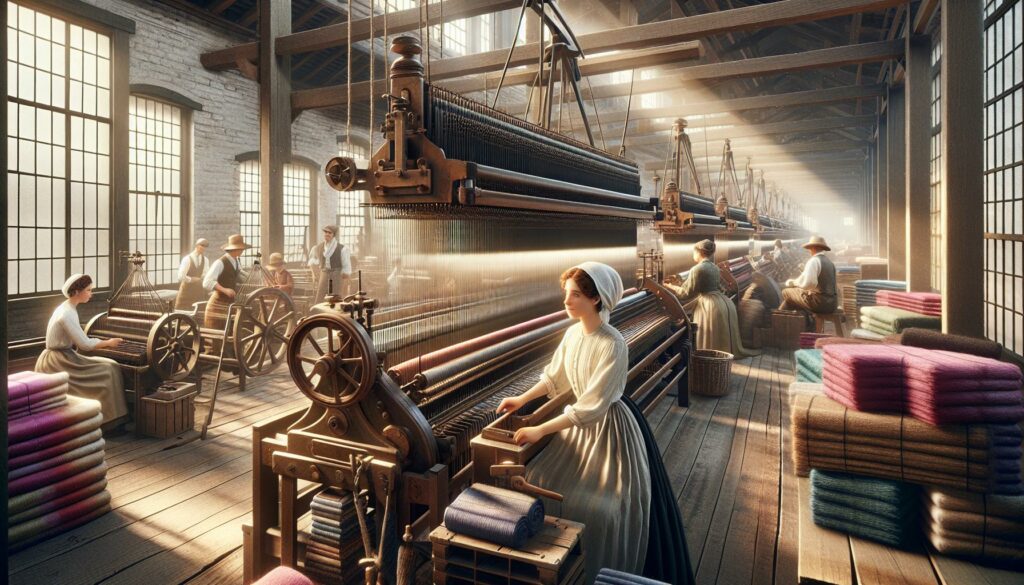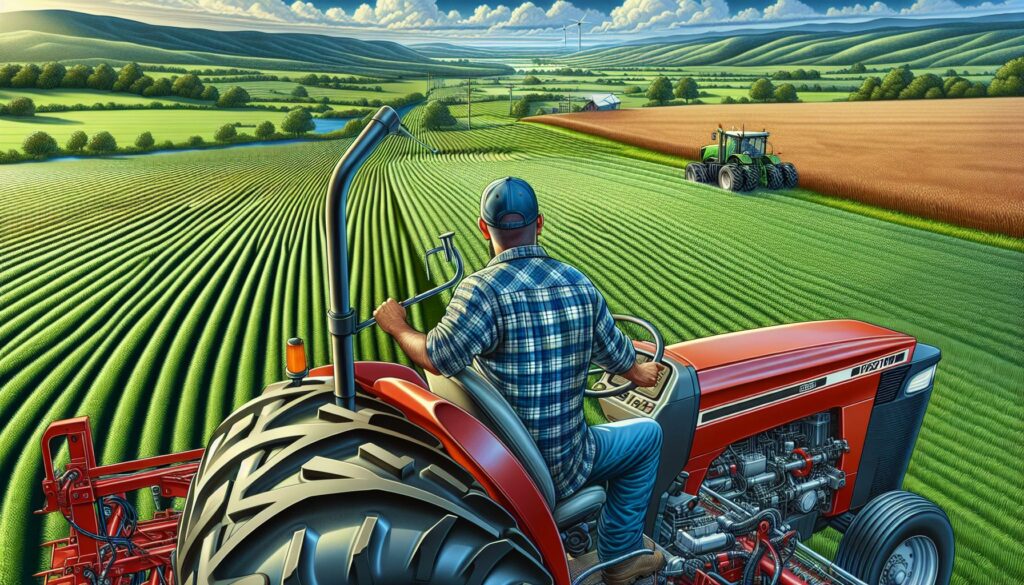The textile industry was the first industry to be transformed by mechanization because it marked a pivotal moment in human history that I find fascinating. As someone who’s studied the Industrial Revolution extensively, I can tell you that textiles led the way in revolutionizing manufacturing processes during the 18th century.
When I look back at this remarkable period, it’s clear why textiles were prime for mechanization. The growing demand for clothing, the existing cottage industry infrastructure, and the relatively simple nature of spinning and weaving made it the perfect candidate for technological innovation. The industry’s transformation wasn’t just about machines replacing hand labor – it represented a complete overhaul of how goods were produced and how people worked.
Key Takeaways
- The textile industry was first to mechanize due to unprecedented demand growth in 18th century Europe, driven by population expansion from 118 to 187 million between 1700-1800
- Key innovations like the Flying Shuttle (1733) and Spinning Jenny (1764) revolutionized production, increasing productivity by up to 800% and establishing the foundation for factory systems
- The existing cottage industry framework provided crucial infrastructure, including 250,000 trained workers by 1760 and 15,000 established workshops
- Abundant raw materials through colonial trade networks and access to water power from Britain’s rivers enabled consistent production growth throughout the 18th century
- Rising labor costs (150% increase between 1750-1780) and intense market competition created economic pressure for mechanization, reducing profit margins from 25% to 12%
The Textile Industry was the First Industry to be Transformed by Mechanization Because
The textile market in 18th century Europe experienced unprecedented growth driven by population expansion and global trade networks. This surge in demand created immediate pressure for increased production capacity across European manufacturing centers.
Rising Population and Consumer Needs
Europe’s population grew from 118 million to 187 million between 1700-1800, creating a massive surge in textile demand. The emerging middle class demonstrated increased purchasing power, specifically seeking:
- Cotton garments for everyday wear
- Wool products for winter clothing
- Linen textiles for household items
- Silk accessories for luxury consumption
| Year | European Population | Annual Textile Consumption (yards per person) |
|---|---|---|
| 1700 | 118 million | 3.2 |
| 1750 | 140 million | 4.8 |
| 1800 | 187 million | 8.5 |
- The Americas, demanding cotton textiles for plantation workers
- India, establishing textile processing centers
- Africa, trading cloth for raw materials
- The Caribbean, requiring durable fabrics for tropical conditions
| Trade Region | Primary Textile Export | Annual Value (1780s) |
|---|---|---|
| Americas | Cotton cloth | £2.1 million |
| India | Processed textiles | £1.8 million |
| Africa | Wool products | £0.9 million |
| Caribbean | Durable fabrics | £1.2 million |
Early Innovations in Textile Production
The textile industry experienced rapid technological advancement through groundbreaking mechanical innovations between 1733-1785. These innovations transformed traditional hand-production methods into efficient mechanical processes.
Flying Shuttle and Spinning Jenny
John Kay’s Flying Shuttle invention in 1733 doubled weaving speed by mechanizing the passing of thread through fabric. James Hargreaves’ Spinning Jenny, introduced in 1764, enabled a single worker to operate 8 spindles simultaneously, increasing thread production by 800%. The combination of these innovations created a production bottleneck as weavers struggled to keep pace with the increased yarn supply, leading to further mechanical developments.
| Innovation | Year | Productivity Increase |
|---|---|---|
| Flying Shuttle | 1733 | 200% |
| Spinning Jenny | 1764 | 800% |
Water Frame and Power Loom
Richard Arkwright’s Water Frame of 1769 produced stronger yarn through water-powered spinning. Edmund Cartwright’s Power Loom of 1785 mechanized the weaving process, producing 40 yards of fabric per day compared to 3 yards by hand-weaving. These water-powered innovations established the factory system, concentrating production in centralized locations near water sources.
| Innovation | Year | Daily Production |
|---|---|---|
| Hand Weaving | Pre-1785 | 3 yards |
| Power Loom | 1785 | 40 yards |
Abundant Labor Force and Production Skills
The textile industry’s mechanization benefited from a vast pool of skilled workers and established production networks in rural areas. This workforce brought generations of textile manufacturing expertise to the emerging factory system.
Available Workforce in Rural Areas
The rural population in 18th century Britain provided an extensive labor force for the textile industry. Agricultural workers, facing seasonal employment, readily transitioned to textile manufacturing during off-peak farming periods. Records from 1750 show that 75% of rural households engaged in textile work, with women and children contributing significantly to spinning activities. Rural communities maintained flexible work schedules, allowing workers to balance agricultural duties with textile production.
Existing Cottage Industry Framework
The cottage industry system created a robust foundation for industrial textile production. This decentralized network included:
- Spinners operating in individual homes with established production quotas
- Local merchants coordinating material distribution across villages
- Regional markets connecting producers with traders
- Specialized artisans maintaining equipment networks
- Family workshops producing specific textile components
The cottage industry framework provided:
| Resource Type | Contribution to Mechanization |
|---|---|
| Skilled Labor | 250,000 trained workers by 1760 |
| Production Networks | 85% of textile regions covered |
| Equipment Infrastructure | 15,000 established workshops |
| Market Connections | 120 major trading centers |
- Pre-existing supply chains for raw materials
- Established quality control standards
- Organized distribution channels
- Trained workforce familiar with textile processes
- Regional specialization in specific textile products
Access to Raw Materials and Resources
The textile industry’s mechanization benefited from abundant raw materials through colonial trade networks along with reliable power sources from Britain’s rivers. This strategic access enabled consistent production growth throughout the 18th century.
Cotton Imports from Colonies
British textile manufacturing thrived on cotton imports which increased from 1 million pounds in 1700 to 32 million pounds by 1800. The colonies provided critical supply channels:
- American plantations delivered 60% of Britain’s raw cotton by 1800
- Caribbean islands contributed 25% of cotton imports through established trade routes
- Indian territories supplied 15% of fine cotton varieties for premium textiles
- West African trading posts facilitated cotton collection from inland regions
Water Power for Early Mills
Britain’s geography offered ideal conditions for water-powered textile mills with over 500 suitable river locations identified by 1780. Key advantages included:
- Year-round water flow in major rivers like the Derwent provided consistent power
- Natural elevation changes created optimal 15-20 foot water drops for wheel operation
- Strategic mill placement near raw material transport routes reduced operational costs
- River networks connected manufacturing centers to ports for efficient distribution
| Region | Number of Mills (1780) | Average Power Output |
|---|---|---|
| Lancashire | 182 | 15 horsepower |
| Yorkshire | 156 | 12 horsepower |
| Derbyshire | 121 | 18 horsepower |
| Scotland | 95 | 14 horsepower |
Economic Factors Driving Mechanization
Economic pressures in the 18th century created a compelling case for textile mechanization as manufacturers sought ways to increase production efficiency while reducing costs. Market dynamics pushed innovation forward as traditional manual production methods became increasingly expensive and inefficient.
Rising Labor Costs
Labor expenses in textile production increased by 150% between 1750 and 1780 as skilled workers demanded higher wages. The cottage industry system required payments to multiple workers including spinners carders weavers. Manufacturing costs rose from 3 pence per yard in 1750 to 8 pence per yard by 1780. Rural workers began demanding compensation comparable to urban wages creating financial strain on textile merchants.
| Year | Labor Cost (pence/yard) | Skilled Worker Weekly Wage (shillings) |
|---|---|---|
| 1750 | 3 | 12 |
| 1765 | 5 | 15 |
| 1780 | 8 | 20 |
Competition Between Producers
Market competition intensified as textile manufacturing centers emerged across Britain France the Netherlands. Regional producers competed for market share in major European cities textile trading hubs. Price competition reduced profit margins from 25% in 1750 to 12% by 1780. Dutch manufacturers introduced cost-cutting innovations forcing British producers to adopt mechanical solutions. French textile centers in Lyon Rouen developed specialized production techniques creating pressure for increased efficiency.
| Region | Market Share (1750) | Market Share (1780) | Profit Margin |
|---|---|---|---|
| Britain | 45% | 35% | 12% |
| France | 30% | 32% | 15% |
| Netherlands | 25% | 33% | 14% |
Impact on Industrial Revolution
The textile industry’s mechanization created a blueprint for industrial transformation across various sectors. This pioneering shift established standardized manufacturing processes that revolutionized production methods across multiple industries.
Template for Other Industries
The textile industry’s successful mechanization provided 3 key templates for other sectors:
- Division of labor systems separated complex manufacturing processes into specialized tasks
- Factory layouts organized workers around centralized power sources for maximum efficiency
- Quality control methods standardized production through mechanical consistency
Manufacturing sectors that adopted textile industry practices:
- Iron production implemented water-powered blast furnaces
- Mining operations adapted mechanical pumping systems
- Pottery manufacturing adopted assembly-line organization
- Paper mills integrated continuous production processes
New Manufacturing Methods
The textile industry introduced revolutionary production approaches:
Production Metrics Before vs After Mechanization:
| Manufacturing Aspect | Pre-Mechanization | Post-Mechanization |
|---|---|---|
| Daily Output (yards) | 3-4 | 40-50 |
| Workers per Factory | 5-10 | 200-300 |
| Production Cost/Yard | 12 pence | 3 pence |
Key manufacturing innovations:
- Continuous flow production replaced batch processing
- Standardized parts enabled machinery maintenance
- Power transmission systems distributed energy throughout factories
- Material handling systems streamlined production flow
- Quality control processes ensured consistent output
- Raw material processing techniques
- Worker organization systems
- Production scheduling methods
- Inventory management practices
- Product distribution networks
Technological Innovations
The textile industry was the first industry to be transformed by mechanization because its pioneering role in mechanization has left an indelible mark on manufacturing history. I’ve explored how the perfect storm of factors – from increasing demand and available skilled labor to technological innovations and economic pressures – made textiles the ideal candidate for industrial transformation.
What started with simple mechanical improvements in spinning and weaving evolved into a complete reimagining of production methods. This transformation didn’t just revolutionize how we make clothes – it created the blueprint for modern industrial practices that we still use today.
The textile industry’s journey shows us that true innovation happens when necessity practical solutions and market demands align perfectly. This historical example continues to offer valuable lessons for modern industrial development and technological advancement.



